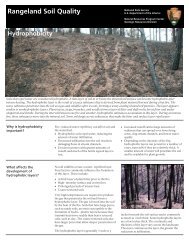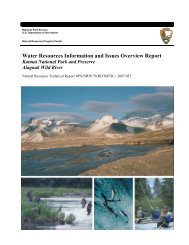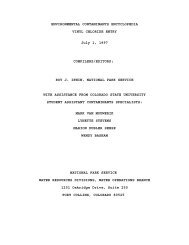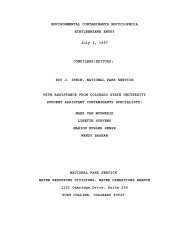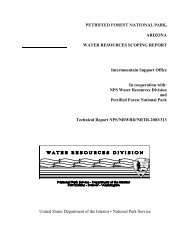ENVIRONMENTAL CONTAMINANTS ENCYCLOPEDIA ...
ENVIRONMENTAL CONTAMINANTS ENCYCLOPEDIA ...
ENVIRONMENTAL CONTAMINANTS ENCYCLOPEDIA ...
You also want an ePaper? Increase the reach of your titles
YUMPU automatically turns print PDFs into web optimized ePapers that Google loves.
For several PAH families (naphthalenes, fluorenes,<br />
phenanthrenes, dibenzothiophenes, and chrysenes) if the<br />
unsubstituted parent PAH is less abundant than the sum of<br />
its counterpart alkyl homologues, the source is more<br />
likely petrogenic (from crude oil or other petroleum<br />
sources) rather than pyrogenic (from high temperature<br />
sources) [942].<br />
Since alkyl versions of this compound are often found in<br />
even greater concentrations than the parent compound, the<br />
following generalizations concerning alkyl vs. parent<br />
compound PAHs should be kept in mind:<br />
Some alkyl PAHs tend to be less volatile than<br />
parent compound PAHs [867]. Alkyl substitution<br />
usually also decreases water solubility [754].<br />
Introduction or extension of an alkyl group<br />
increases not only persistence but also<br />
lipophilicity; increased lipophilicity is often<br />
associated with increased absorption [856]. Alkyl<br />
PAHs tend to bioaccumulate to a greater degree than<br />
parent compound PAHs [347,885].<br />
Alkylated PAHs are often more abundant than parent<br />
compounds [468], at least those alkyl PAHs<br />
originating from petrogenic sources [942].<br />
Alkyl PAHs also tend to persist for a longer time<br />
than the parent PAHs [468,856]. PAH persistence<br />
tends to increase with increasing alkyl<br />
substitution; for example, methyl naphthalene is<br />
more persistent than naphthalene (the parent<br />
compound) and dimethyl naphthalene is still more<br />
persistent than methyl naphthalene in sediments and<br />
amphipod tissues [885].<br />
Comparing PAHs and alkyl PAHs, the parent compound<br />
is typically the first to degrade. Thus, as mixed<br />
composition petroleum products age, the percentage<br />
of alkyl PAHs vs. PAHs increases, yet most standard<br />
EPA scans (even 8270) do not pick up alkyl PAHs<br />
[796]. This, coupled with the need for lower<br />
detection limits and the general hazards presented<br />
by alkyl PAHs, is one reason the NOAA protocol<br />
expanded scan [828] or other rigorous scans using<br />
Selected Ion Monitoring (SIM) [942] are often<br />
recommended rather than the older standard EPA<br />
scans.<br />
Environmental Fate/Exposure Summary [366]:<br />
Once in the atmosphere, naphthalene rapidly photodegrades<br />
(half-life 3-8 hr). Releases into water are lost due to





